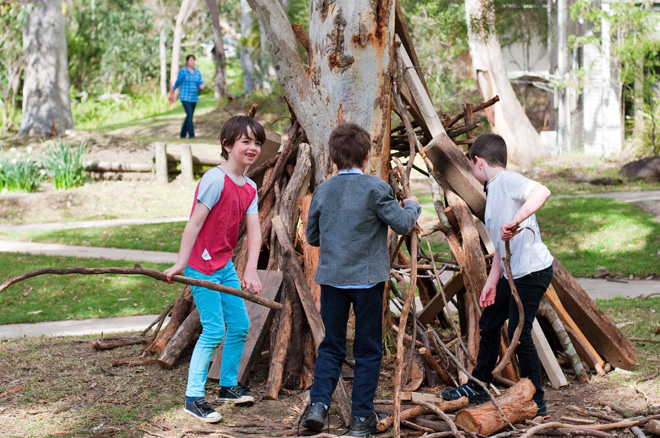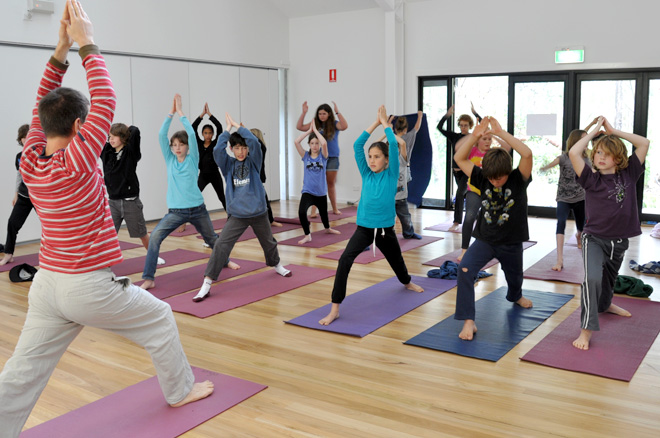Latest news
Moving bodies, Growing minds
11,12 and 13 year olds, some of the pre highs (year before high school) walk a 5 km return trip to the local shops (weekly) to buy lunch as part of their independence rights. Perhaps this is personal development, PE or part of the HSIE (Human Society and its Environment) curriculum?
At Kinma, a Pre-school and Primary School, in Sydney’s Terrey Hills, movement is woven into daily learning experiences so that most children are physically moving for a third to a half of their day. Much of this is in nature’s playground, as they are fortunate to be positioned on five acres of bushland, bordering Guringai National Parks. As learning experiences are integrated, the students are not artificially pigeon holing their life into subjects, they simply live, work, play, moving through a lot of it, learning all the time.
Kinma has a unique learning program, which has been fine tuned over its 43 year history, ensuring always, that each individual receives an education balancing their unique physical, emotional, social and intellectual needs with that of the broader community life in which they are active participants. And all this fused through the new national curriculum!
While you will find students at swimming lessons, tennis, jiu-jitsu, yoga and basketball lessons throughout the year, that is not where movement ends. It’s the mere beginning. Brain –gym starts many days and is peppered throughout the day. It is a movement based program devised by allied health professionals to co-ordinate brain and body. This together with movement based music, drama and art experiences for the first half hour for most students, allows for a natural transition into the Kinma school day. Neurological research over the last decade evidences what Kinma has been doing for 43 years, honouring the child’s natural need to move as PART of their learning, not as something separate and distinct from it.

Given that some 30-60% of children have kinesthesia as their prime mode of absorbing new learning, and 100% of children use it in some form (aural, oral and visual being other key modes), it has a high value and is naturally fused in the Kinma curriculum. Teachers look for experiences which engage body as they are aware that minds will, as a result, process more deeply. Experiences which involve sitting for extended time periods are buffered either end by movement. Teachers find that almost all students can then be attentive to processes of writing, drawing, computing, reading or manipulation of any broad assortment of resources. Creativity, critical thinking and toolbox skills (arithmetic processes, spelling rules etc) can then be the focus rather than the skill of trying to be attentive. Stress of being eternally still is not being simultaneously managed with the task at hand. The body is healthily pumping its electrical and chemical systems to support rather than detract from learning.
Out-times are special times at Kinma. From 10.30-11 and from 12.30-1.15, after eating, children create their worlds in their nature’s playground. Students inhabit a wonderland in which trees, a creek, assorted grass spaces, fields, plants, gardens, rocks and animals are their resources for play, perhaps one of the deepest forms of learning.
Much education of healthy bodies with both students and families takes place at Kinma. The vital role of hydration, of nutritious ‘brain and body feeding foods, sleep and movement feature strongly. Families engage and share their growing knowledge in a range of forums.
Physiotherapists, yoga teachers and other health professionals have visited Kinma over 43 years and been amazed at the general wellbeing of the children; the virtual absence of obesity, their stance and posture (bare feet permitted through sunny seasons is a bonus), their agility and perhaps most strikingly, the laughter, the joy and the depth of communication among students, staff and families. It is this last facet, the emotional health, which is perhaps most evident. Interns from all NSW’s top universities as well as international students from assorted countries vie for positions in the practica programs so that they may learn alongside the teaching staff and experience the particular Kinma restorative justice/ emotional-social wellbeing practices. Healthy body movement is paramount in this equation.
As you are leaving the school, you notice the gardeners, Class 2 (aged 7-9) moving around their garden with care and joy. They know where the tomatoes are planted for not only did they plant them, they worked out exactly where the seeds be best placed when designing their garden. They create water, compost and labelling systems, design timetables and are learning what needs weeding and what is beneficial for each plant which they tend carefully during out-time ( lunch hour).
Moving bodies, growing minds. Moving minds, healthy and happy students. Kinma’s movement based reality.
- Juli G, Educational Co-Ordinator

Term Dates 2025
- Term 1: Tues 4 February to Fri 11 April
- Term 2: Wed 30 April to Fri 27 June
- Term 3: Wed 23 July to Fri 26 Sep
- Term 4: Wed 15 Oct to Wed 17 Dec
Term Dates 2026
- Term 1: Mon 2 Feb – Thu 2 April
- Term 2: Wed 22 April – Fri 26 June
- Term 3: Wed 22 July – Fri 25 Sep
- Term 4: Wed 14 oct – Wed 16 Dec
Contact us
127 Coolowie Rd,
Terrey Hills NSW 2084
Find us on Google Maps
Primary: +61 2 9450 0738
Preschool: +61 2 9486 3018
Email Kinma

